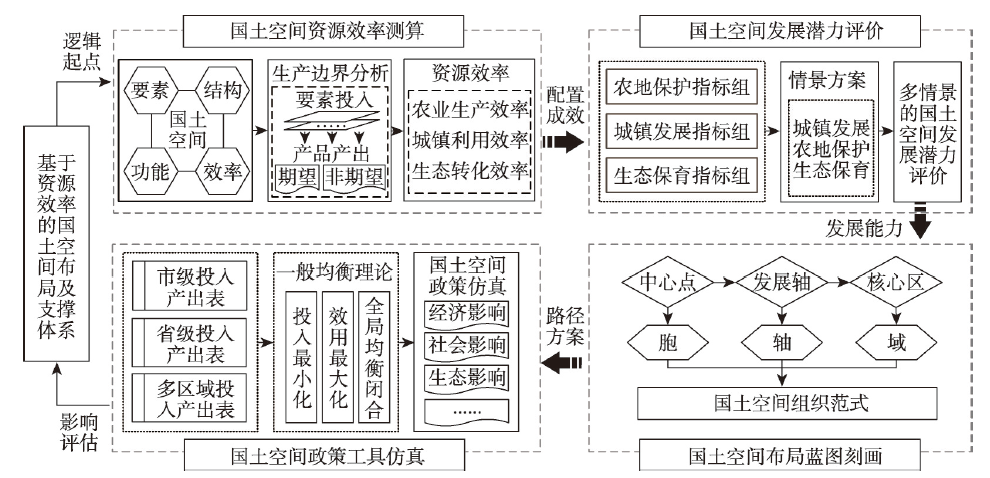

基于资源效率的国土空间布局及支撑体系框架
|
金贵(1986-), 男, 江苏邳州人, 博士, 教授, 博士生导师, 主要从事土地资源管理研究。E-mail: jingui@igsnrr.ac.cn |
收稿日期: 2021-07-16
要求修回日期: 2021-12-31
网络出版日期: 2022-05-23
基金资助
国家自然科学基金项目(71974070)
国家自然科学基金项目(41501593)
教育部人文社会科学研究基金项目(19YJCZH068)
版权
Layout optimization and support system of territorial space: An analysis framework based on resource efficiency
Received date: 2021-07-16
Request revised date: 2021-12-31
Online published: 2022-05-23
Supported by
National Natural Science Foundation of China(71974070)
National Natural Science Foundation of China(41501593)
Humanities and Social Sciences Foundation of Ministry of Education of China(19YJCZH068)
Copyright
形成国土空间开发保护新格局是生态文明建设的首要任务之一,关键在于城镇、农业和生态空间的合理配置,重点是以较小的资源损耗支撑社会经济可持续发展,而深入理解资源效率的作用成效是科学优化国土空间布局的前提。本文框架以城镇利用、农业生产和生态转换效率测算为逻辑起点,构建以上述效率为核心的国土空间开发保护情景方案和评价指标体系,引入体现决策偏好差异模型评价国土空间发展潜力,定量刻画不同情景方案下的国土空间布局蓝图,最后通过综合性分析范式对不同决策导向的国土空间政策工具(布局蓝图)进行模拟和优选。本文通过揭示资源效率对国土空间开发保护的作用成效,提炼国土空间布局蓝图定量刻画的具体规律,构建权衡多方利弊的全局优化策略,为国家生态文明建设和自然资源统筹管理提供理论参考。

金贵 , 郭柏枢 , 成金华 , 邓祥征 , 吴锋 . 基于资源效率的国土空间布局及支撑体系框架[J]. 地理学报, 2022 , 77(3) : 534 -546 . DOI: 10.11821/dlxb202203003
Forming a new territorial spatial pattern to rebalance the orientation of development and protection is one of the primary tasks in ecological civilization construction. The key to providing an effective territorial spatial pattern lies in realizing the rational allocation of urban space, agricultural space, and ecological space to support high-quality social and economic development as well as reducing the consumption of resources. Therefore, an in-depth understanding of the effects of resource efficiency on spatiotemporal patterns is a prerequisite for optimizing territorial space in a scientific manner. The technical framework in this paper analyses the resource efficiency of urban development, agricultural production, and ecological conservation as the logical starting point for the development of an optimal territorial spatial pattern. Firstly, the scenarios and index systems for the development and protections centered on resource efficiency are to be constructed; secondly, methods that reflect the preferences of decision-makers are to be designed, which will subsequently allow for the development capacity to be evaluated; thirdly, the blueprints of territorial space under different scenarios are to be created; and, finally, socioeconomic and ecological impacts of policy tools (blueprints) under different decision-making preferences are to be simulated based on comprehensive analysis tools. The research framework includes the following contents: the evaluation of the effectiveness of the allocation of territorial space from the perspective of resource efficiency, the refinement of specific laws for quantitatively portraying blueprints, and the construction of a global optimization strategy that weighs the pros and cons of various options for all parties involved. The research framework and its application can then be used as references for natural resources management and ecological civilization construction.

| [1] |
[杨伟民. 构建国土空间开发保护新格局. 经济日报, 2020-12-23(010).]
|
| [2] |
[陆大道. 长江大保护与长江经济带的可持续发展: 关于落实习总书记重要指示, 实现长江经济带可持续发展的认识与建议. 地理学报, 2018, 73(10): 1829-1836.]
|
| [3] |
[樊杰, 赵艳楠. 面向现代化的中国区域发展格局: 科学内涵与战略重点. 经济地理, 2021, 41(1): 1-9.]
|
| [4] |
[陆昊. 全面提高资源利用效率. 人民日报, 2021-01-15(009).]
|
| [5] |
[吴志强. 国土空间规划的五个哲学问题. 城市规划学刊, 2020(6): 7-10.]
|
| [6] |
[焦利民, 刘耀林. 可持续城市化与国土空间优化. 武汉大学学报: 信息科学版, 2021, 46(1): 1-11.]
|
| [7] |
[王静, 袁昕怡, 陈晔, 等. 面向可持续城市生态系统管理的资源环境承载力评价方法与实践应用: 以烟台市为例. 自然资源学报, 2020, 35(10): 2371-2384.]
|
| [8] |
[吴宇哲, 潘绘羽. 国土空间规划中“双评价”的内在逻辑与外部定位. 河海大学学报(哲学社会科学版), 2021, 23(1): 73-79, 107.]
|
| [9] |
[郭仁忠, 罗平, 罗婷文. 土地管理三维思维与土地空间资源认知. 地理研究, 2018, 37(4): 649-658.]
|
| [10] |
[诸大建. 在“行星边界”内追求可持续发展目标的实现. 可持续发展经济导刊, 2019(7): 53-56.]
|
| [11] |
[林坚, 叶子君, 杨红. 存量规划时代城镇低效用地再开发的思考. 中国土地科学, 2019, 33(9): 1-8.]
|
| [12] |
|
| [13] |
|
| [14] |
|
| [15] |
[金贵, 邓祥征, 赵晓东, 等. 2005—2014年长江经济带城市土地利用效率时空格局特征. 地理学报, 2018, 73(7): 1242-1252.]
|
| [16] |
|
| [17] |
[金贵, 王占岐, 姚小薇, 等. 国土空间分区的概念与方法探讨. 中国土地科学, 2013, 27(5): 48-53.]
|
| [18] |
|
| [19] |
|
| [20] |
[刘昌明, 李宗礼, 王中根, 等. 河湖水系连通的关键科学问题与研究方向. 地理学报, 2021, 76(3): 505-512.]
|
| [21] |
[黄贤金, 宋娅娅. 基于共轭角力机制的区域资源环境综合承载力评价模型. 自然资源学报, 2019, 34(10): 2103-2112.]
|
| [22] |
[葛全胜, 刘卫东, 孙鸿烈, 等. 地理科学与资源科学的国家智库建设. 地理学报, 2020, 75(12): 2655-2668.]
|
| [23] |
[方创琳, 王振波, 刘海猛. 美丽中国建设的理论基础与评估方案探索. 地理学报, 2019, 74(4): 619-632.]
|
| [24] |
|
| [25] |
[周成虎, 孙九林, 苏奋振, 等. 地理信息科学发展与技术应用. 地理学报, 2020, 75(12): 2593-2609.]
|
| [26] |
[龙花楼, 陈坤秋. 基于土地系统科学的土地利用转型与城乡融合发展. 地理学报, 2021, 76(2): 295-309.]
|
| [27] |
[彭建, 李慧蕾, 刘焱序, 等. 雄安新区生态安全格局识别与优化策略. 地理学报, 2018, 73(4): 701-710.]
|
| [28] |
[陆大道, 孙东琪. 黄河流域的综合治理与可持续发展. 地理学报, 2019, 74(12): 2431-2436.]
|
| [29] |
[樊杰. 地域功能—结构的空间组织途径: 对国土空间规划实施主体功能区战略的讨论. 地理研究, 2019, 38(10): 2373-2387.]
|
| [30] |
[金凤君, 姚作林, 陈卓. 环南海区域发展特征与一体化经济区建设前景. 地理学报, 2021, 76(2): 428-443.]
|
| [31] |
[陈明星, 梁龙武, 王振波, 等. 美丽中国与国土空间规划关系的地理学思考. 地理学报, 2019, 74(12): 2467-2481.]
|
| [32] |
[于贵瑞, 李文华, 邵明安, 等. 生态系统科学研究与生态系统管理. 地理学报, 2020, 75(12): 2620-2635.]
|
| [33] |
[刘耀彬, 邱浩, 戴璐. 生态安全约束下城市群空间网络结构动态演变及关联特征分析: 以环鄱阳湖城市群为例. 华中师范大学学报: 自然科学版, 2020, 54(4): 522-535.]
|
| [34] |
[唐常春, 李亚平, 杜也, 等. 1980—2018年粤港澳大湾区国土空间结构演变. 地理研究, 2021, 40(4): 928-944.]
|
| [35] |
[吴健生, 罗可雨, 马洪坤, 等. 基于生态系统服务与引力模型的珠三角生态安全与修复格局研究. 生态学报, 2020, 40(23): 8417-8429.]
|
| [36] |
|
| [37] |
[李力, 温来成, 唐遥, 等. 货币政策与宏观审慎政策双支柱调控下的地方政府债务风险治理. 经济研究, 2020, 55(11): 36-49.]
|
| [38] |
|
| [39] |
[陈锡康, 杨翠红, 祝坤福, 等. 2021年中国经济增长速度的预测分析与政策建议. 中国科学院院刊, 2021, 36(1): 37-46.]
|
| [40] |
|
| [41] |
[宋长青, 程昌秀, 史培军. 新时代地理复杂性的内涵. 地理学报, 2018, 73(7): 1204-1213.]
|
| [42] |
[金贵, 邓祥征, 张倩, 等. 武汉城市圈国土空间综合功能分区. 地理研究, 2017, 36(3): 541-552.]
|
| [43] |
|
| [44] |
|
| [45] |
|
/
| 〈 |
|
〉 |